Developing Manager Report: Organisational Culture and Change
VerifiedAdded on 2020/12/18
|22
|6129
|233
Report
AI Summary
This report delves into the multifaceted role of a developing manager, focusing on the Clayton Crown Hotel in London as a case study. It begins by comparing various management styles, including hierarchy of needs, contingency approaches, and democratic leadership. The report then explores key leadership characteristics such as empathy, consistency, honesty, and communication, highlighting their impact on team dynamics and organisational success. It also analyses communication processes within the business, outlining elements like sender, encoding, message, channel, receiver, decoding, and feedback, and discusses potential barriers. Furthermore, the report examines organisational culture, using Handy's model to define different cultural types and exploring the impact of change within an organisation. The report also addresses planned change theory, providing a comprehensive overview of management practices and challenges.
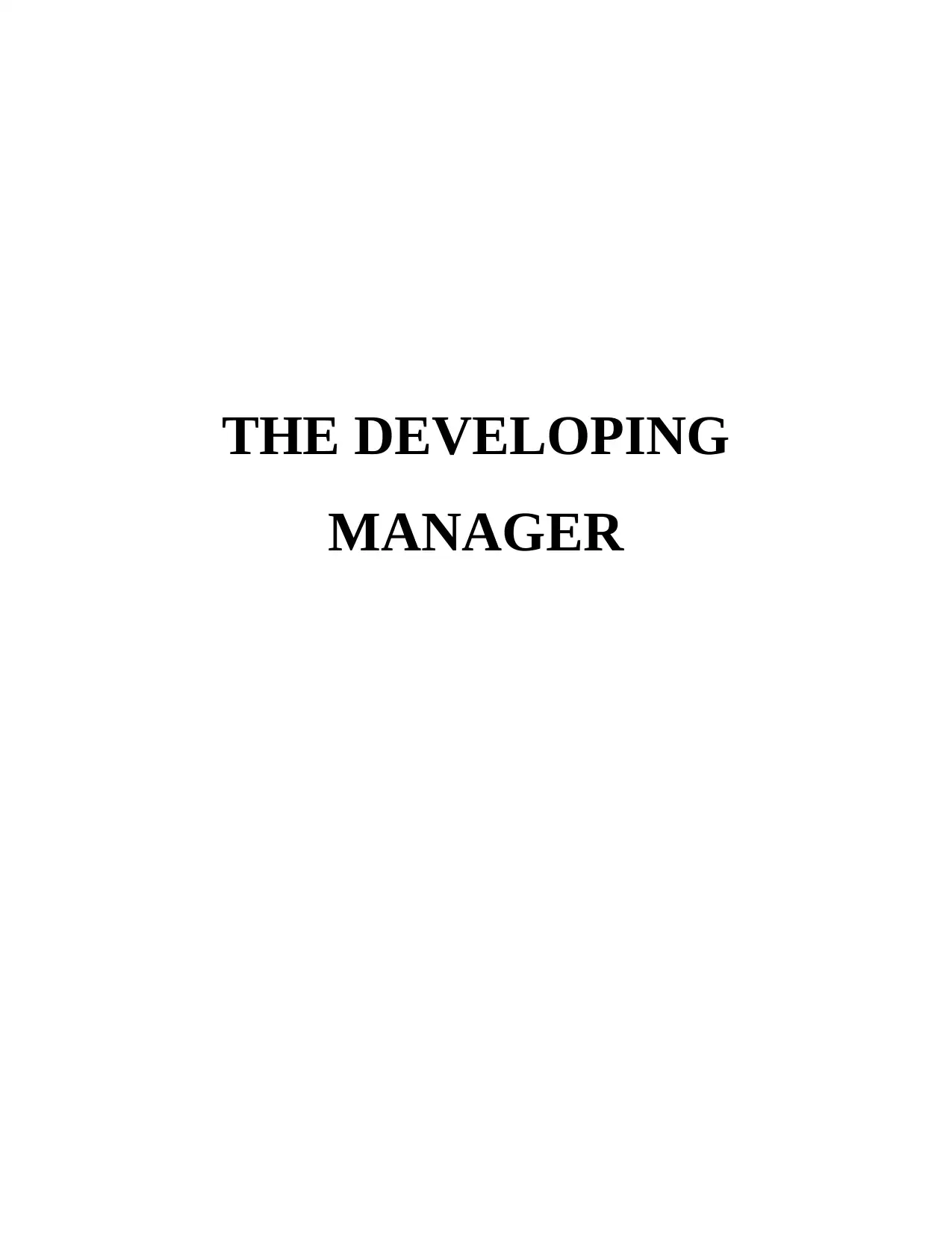
THE DEVELOPING
MANAGER
MANAGER
Paraphrase This Document
Need a fresh take? Get an instant paraphrase of this document with our AI Paraphraser
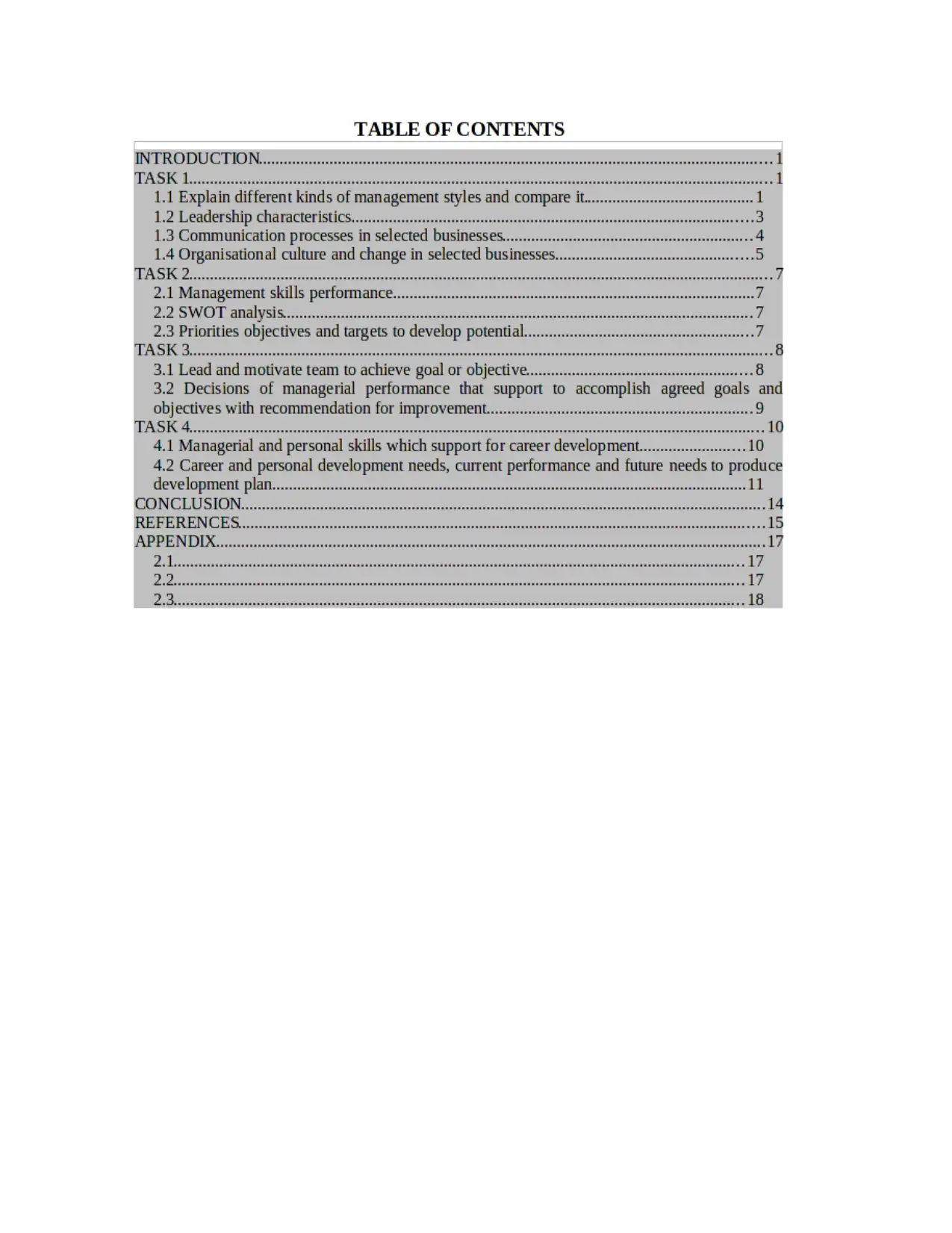
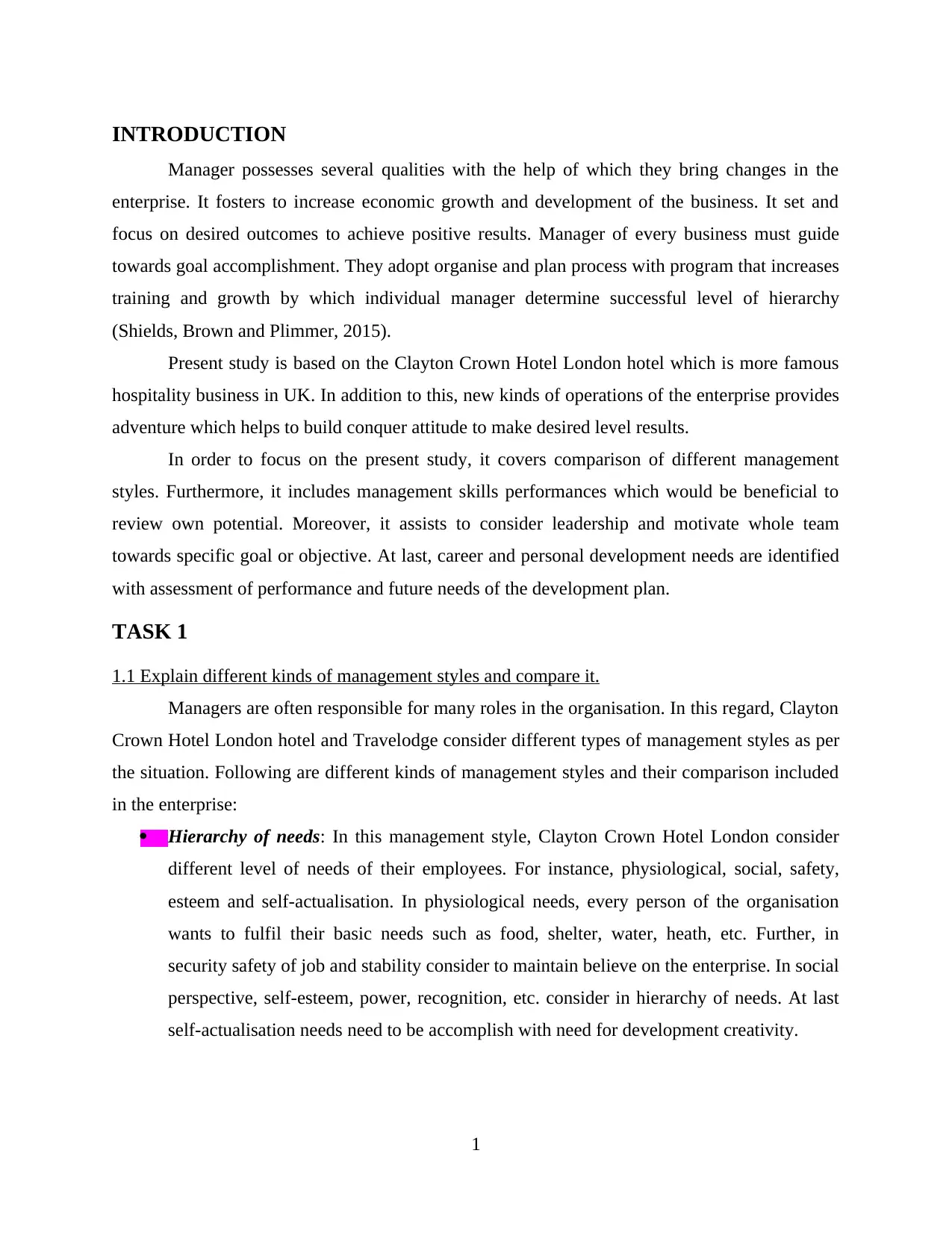
INTRODUCTION
Manager possesses several qualities with the help of which they bring changes in the
enterprise. It fosters to increase economic growth and development of the business. It set and
focus on desired outcomes to achieve positive results. Manager of every business must guide
towards goal accomplishment. They adopt organise and plan process with program that increases
training and growth by which individual manager determine successful level of hierarchy
(Shields, Brown and Plimmer, 2015).
Present study is based on the Clayton Crown Hotel London hotel which is more famous
hospitality business in UK. In addition to this, new kinds of operations of the enterprise provides
adventure which helps to build conquer attitude to make desired level results.
In order to focus on the present study, it covers comparison of different management
styles. Furthermore, it includes management skills performances which would be beneficial to
review own potential. Moreover, it assists to consider leadership and motivate whole team
towards specific goal or objective. At last, career and personal development needs are identified
with assessment of performance and future needs of the development plan.
TASK 1
1.1 Explain different kinds of management styles and compare it.
Managers are often responsible for many roles in the organisation. In this regard, Clayton
Crown Hotel London hotel and Travelodge consider different types of management styles as per
the situation. Following are different kinds of management styles and their comparison included
in the enterprise:
Hierarchy of needs: In this management style, Clayton Crown Hotel London consider
different level of needs of their employees. For instance, physiological, social, safety,
esteem and self-actualisation. In physiological needs, every person of the organisation
wants to fulfil their basic needs such as food, shelter, water, heath, etc. Further, in
security safety of job and stability consider to maintain believe on the enterprise. In social
perspective, self-esteem, power, recognition, etc. consider in hierarchy of needs. At last
self-actualisation needs need to be accomplish with need for development creativity.
1
Manager possesses several qualities with the help of which they bring changes in the
enterprise. It fosters to increase economic growth and development of the business. It set and
focus on desired outcomes to achieve positive results. Manager of every business must guide
towards goal accomplishment. They adopt organise and plan process with program that increases
training and growth by which individual manager determine successful level of hierarchy
(Shields, Brown and Plimmer, 2015).
Present study is based on the Clayton Crown Hotel London hotel which is more famous
hospitality business in UK. In addition to this, new kinds of operations of the enterprise provides
adventure which helps to build conquer attitude to make desired level results.
In order to focus on the present study, it covers comparison of different management
styles. Furthermore, it includes management skills performances which would be beneficial to
review own potential. Moreover, it assists to consider leadership and motivate whole team
towards specific goal or objective. At last, career and personal development needs are identified
with assessment of performance and future needs of the development plan.
TASK 1
1.1 Explain different kinds of management styles and compare it.
Managers are often responsible for many roles in the organisation. In this regard, Clayton
Crown Hotel London hotel and Travelodge consider different types of management styles as per
the situation. Following are different kinds of management styles and their comparison included
in the enterprise:
Hierarchy of needs: In this management style, Clayton Crown Hotel London consider
different level of needs of their employees. For instance, physiological, social, safety,
esteem and self-actualisation. In physiological needs, every person of the organisation
wants to fulfil their basic needs such as food, shelter, water, heath, etc. Further, in
security safety of job and stability consider to maintain believe on the enterprise. In social
perspective, self-esteem, power, recognition, etc. consider in hierarchy of needs. At last
self-actualisation needs need to be accomplish with need for development creativity.
1
⊘ This is a preview!⊘
Do you want full access?
Subscribe today to unlock all pages.

Trusted by 1+ million students worldwide
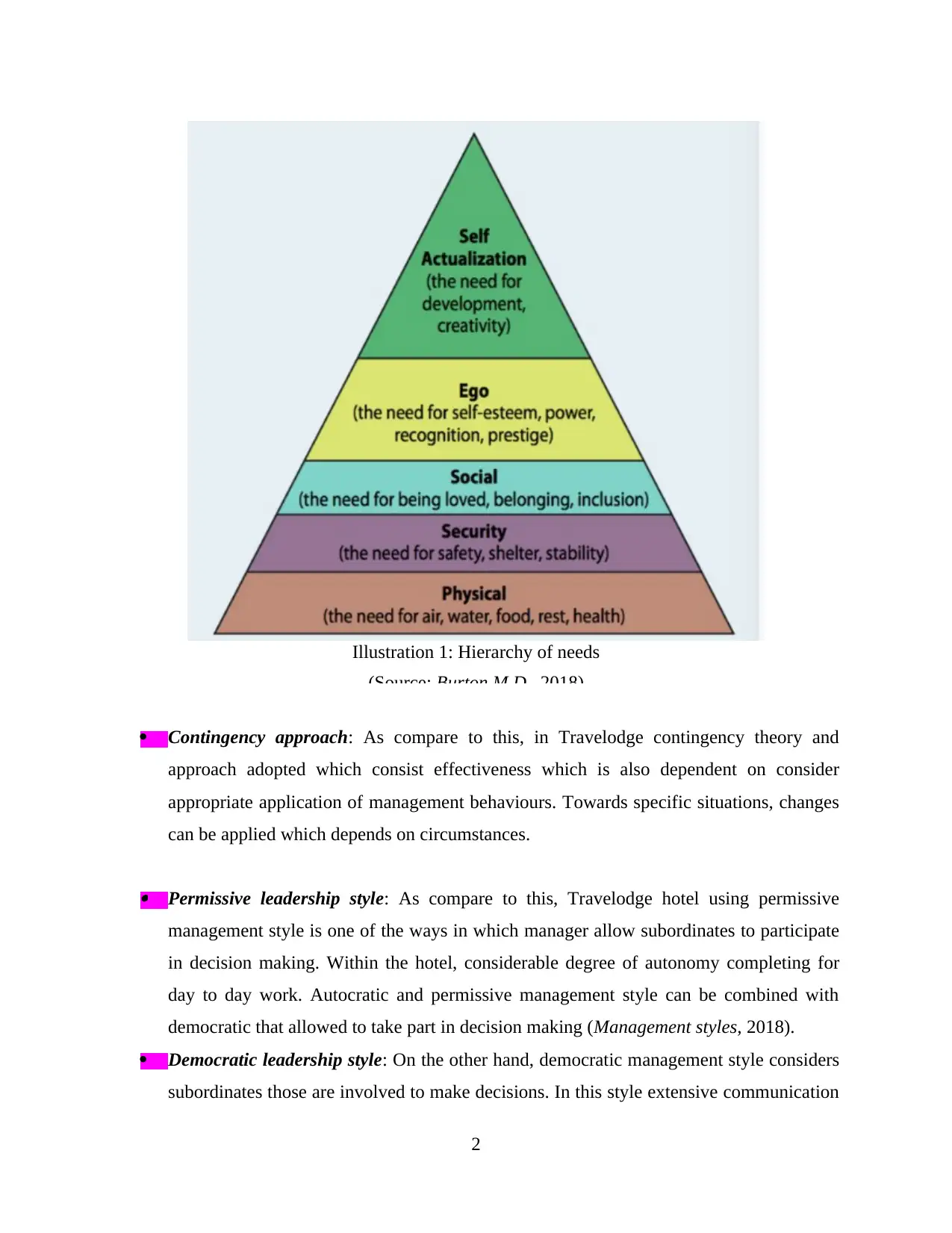
Contingency approach: As compare to this, in Travelodge contingency theory and
approach adopted which consist effectiveness which is also dependent on consider
appropriate application of management behaviours. Towards specific situations, changes
can be applied which depends on circumstances.
Permissive leadership style: As compare to this, Travelodge hotel using permissive
management style is one of the ways in which manager allow subordinates to participate
in decision making. Within the hotel, considerable degree of autonomy completing for
day to day work. Autocratic and permissive management style can be combined with
democratic that allowed to take part in decision making (Management styles, 2018).
Democratic leadership style: On the other hand, democratic management style considers
subordinates those are involved to make decisions. In this style extensive communication
2
Illustration 1: Hierarchy of needs
(Source: Burton M.D., 2018)
approach adopted which consist effectiveness which is also dependent on consider
appropriate application of management behaviours. Towards specific situations, changes
can be applied which depends on circumstances.
Permissive leadership style: As compare to this, Travelodge hotel using permissive
management style is one of the ways in which manager allow subordinates to participate
in decision making. Within the hotel, considerable degree of autonomy completing for
day to day work. Autocratic and permissive management style can be combined with
democratic that allowed to take part in decision making (Management styles, 2018).
Democratic leadership style: On the other hand, democratic management style considers
subordinates those are involved to make decisions. In this style extensive communication
2
Illustration 1: Hierarchy of needs
(Source: Burton M.D., 2018)
Paraphrase This Document
Need a fresh take? Get an instant paraphrase of this document with our AI Paraphraser
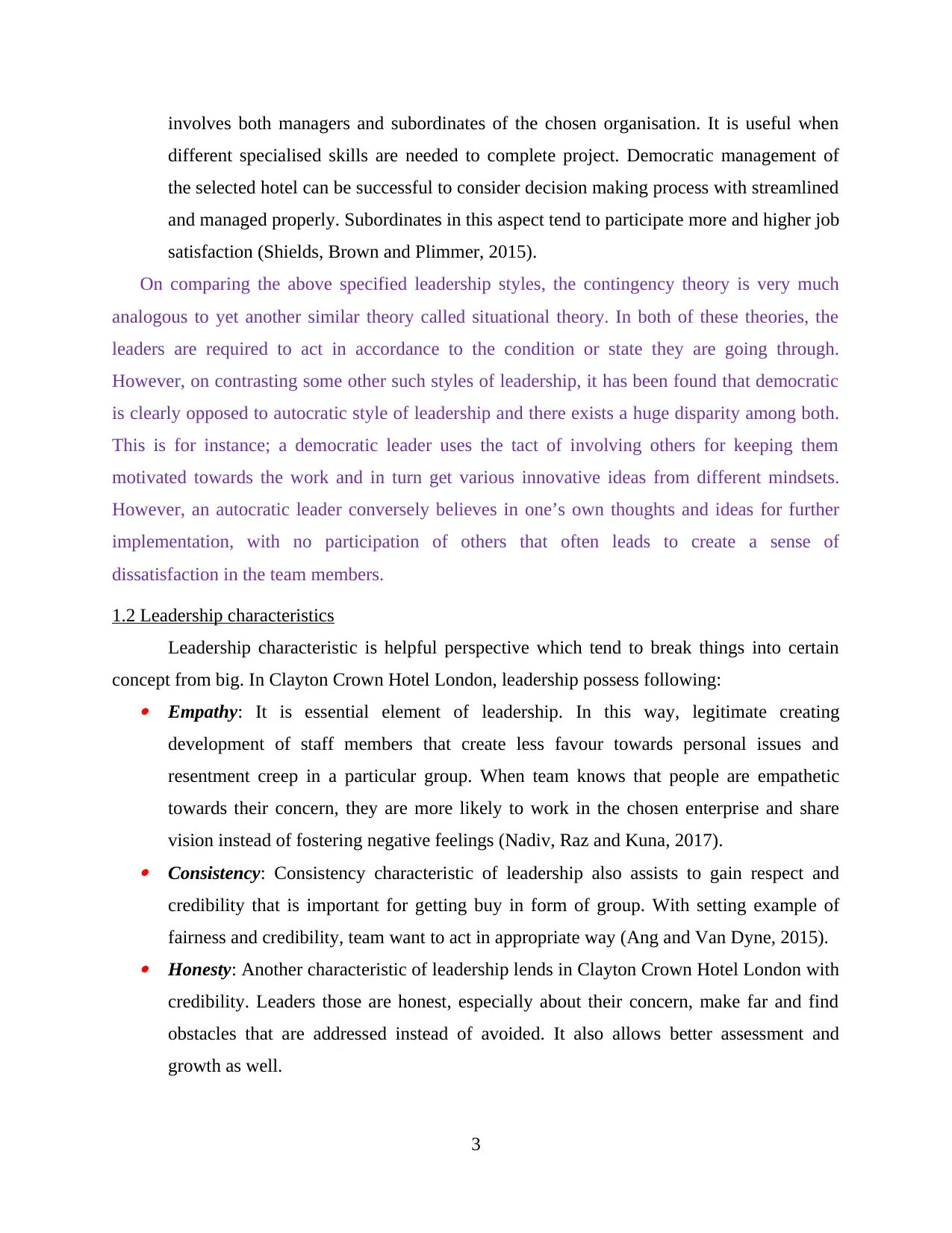
involves both managers and subordinates of the chosen organisation. It is useful when
different specialised skills are needed to complete project. Democratic management of
the selected hotel can be successful to consider decision making process with streamlined
and managed properly. Subordinates in this aspect tend to participate more and higher job
satisfaction (Shields, Brown and Plimmer, 2015).
On comparing the above specified leadership styles, the contingency theory is very much
analogous to yet another similar theory called situational theory. In both of these theories, the
leaders are required to act in accordance to the condition or state they are going through.
However, on contrasting some other such styles of leadership, it has been found that democratic
is clearly opposed to autocratic style of leadership and there exists a huge disparity among both.
This is for instance; a democratic leader uses the tact of involving others for keeping them
motivated towards the work and in turn get various innovative ideas from different mindsets.
However, an autocratic leader conversely believes in one’s own thoughts and ideas for further
implementation, with no participation of others that often leads to create a sense of
dissatisfaction in the team members.
1.2 Leadership characteristics
Leadership characteristic is helpful perspective which tend to break things into certain
concept from big. In Clayton Crown Hotel London, leadership possess following: Empathy: It is essential element of leadership. In this way, legitimate creating
development of staff members that create less favour towards personal issues and
resentment creep in a particular group. When team knows that people are empathetic
towards their concern, they are more likely to work in the chosen enterprise and share
vision instead of fostering negative feelings (Nadiv, Raz and Kuna, 2017). Consistency: Consistency characteristic of leadership also assists to gain respect and
credibility that is important for getting buy in form of group. With setting example of
fairness and credibility, team want to act in appropriate way (Ang and Van Dyne, 2015). Honesty: Another characteristic of leadership lends in Clayton Crown Hotel London with
credibility. Leaders those are honest, especially about their concern, make far and find
obstacles that are addressed instead of avoided. It also allows better assessment and
growth as well.
3
different specialised skills are needed to complete project. Democratic management of
the selected hotel can be successful to consider decision making process with streamlined
and managed properly. Subordinates in this aspect tend to participate more and higher job
satisfaction (Shields, Brown and Plimmer, 2015).
On comparing the above specified leadership styles, the contingency theory is very much
analogous to yet another similar theory called situational theory. In both of these theories, the
leaders are required to act in accordance to the condition or state they are going through.
However, on contrasting some other such styles of leadership, it has been found that democratic
is clearly opposed to autocratic style of leadership and there exists a huge disparity among both.
This is for instance; a democratic leader uses the tact of involving others for keeping them
motivated towards the work and in turn get various innovative ideas from different mindsets.
However, an autocratic leader conversely believes in one’s own thoughts and ideas for further
implementation, with no participation of others that often leads to create a sense of
dissatisfaction in the team members.
1.2 Leadership characteristics
Leadership characteristic is helpful perspective which tend to break things into certain
concept from big. In Clayton Crown Hotel London, leadership possess following: Empathy: It is essential element of leadership. In this way, legitimate creating
development of staff members that create less favour towards personal issues and
resentment creep in a particular group. When team knows that people are empathetic
towards their concern, they are more likely to work in the chosen enterprise and share
vision instead of fostering negative feelings (Nadiv, Raz and Kuna, 2017). Consistency: Consistency characteristic of leadership also assists to gain respect and
credibility that is important for getting buy in form of group. With setting example of
fairness and credibility, team want to act in appropriate way (Ang and Van Dyne, 2015). Honesty: Another characteristic of leadership lends in Clayton Crown Hotel London with
credibility. Leaders those are honest, especially about their concern, make far and find
obstacles that are addressed instead of avoided. It also allows better assessment and
growth as well.
3
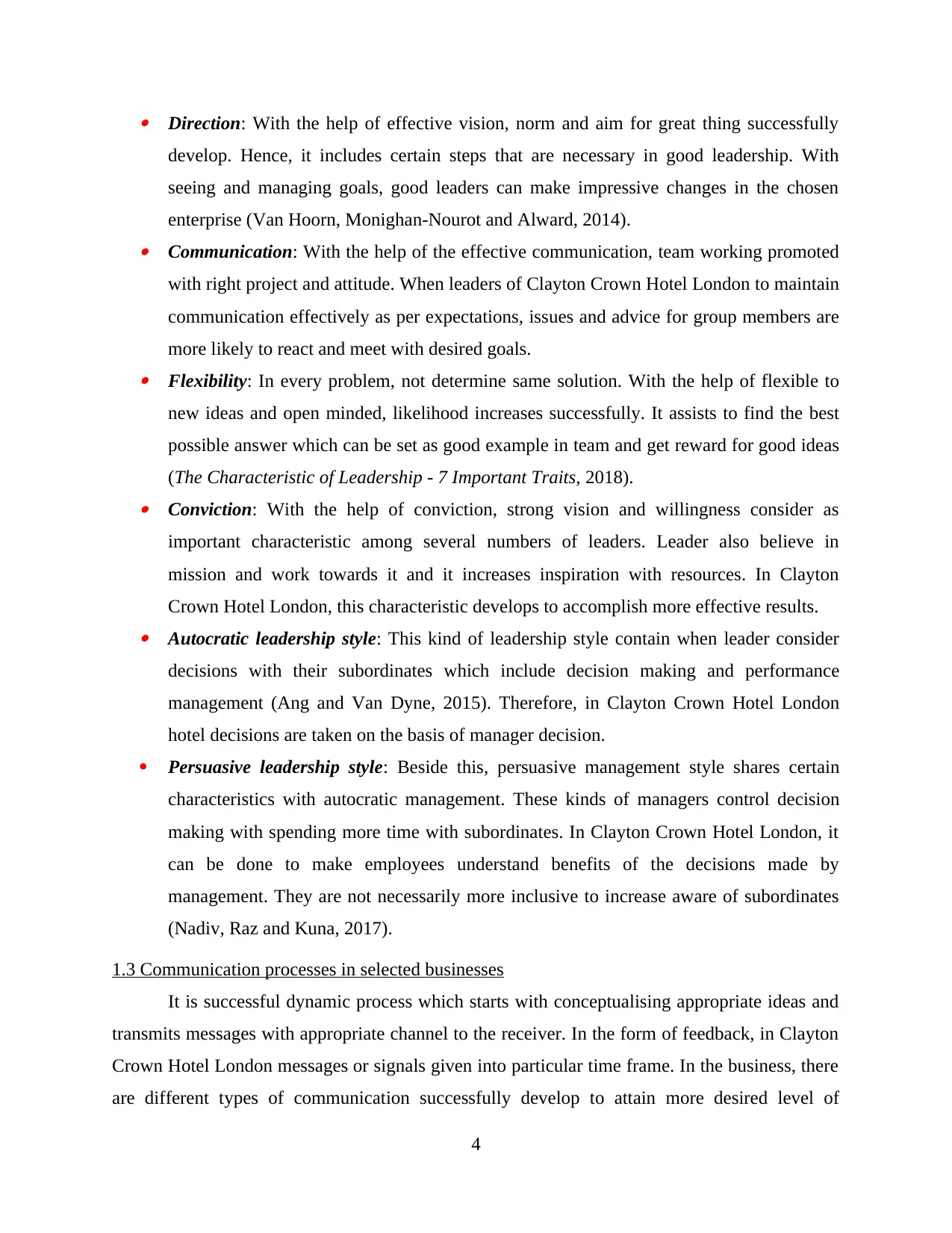
Direction: With the help of effective vision, norm and aim for great thing successfully
develop. Hence, it includes certain steps that are necessary in good leadership. With
seeing and managing goals, good leaders can make impressive changes in the chosen
enterprise (Van Hoorn, Monighan-Nourot and Alward, 2014). Communication: With the help of the effective communication, team working promoted
with right project and attitude. When leaders of Clayton Crown Hotel London to maintain
communication effectively as per expectations, issues and advice for group members are
more likely to react and meet with desired goals. Flexibility: In every problem, not determine same solution. With the help of flexible to
new ideas and open minded, likelihood increases successfully. It assists to find the best
possible answer which can be set as good example in team and get reward for good ideas
(The Characteristic of Leadership - 7 Important Traits, 2018). Conviction: With the help of conviction, strong vision and willingness consider as
important characteristic among several numbers of leaders. Leader also believe in
mission and work towards it and it increases inspiration with resources. In Clayton
Crown Hotel London, this characteristic develops to accomplish more effective results. Autocratic leadership style: This kind of leadership style contain when leader consider
decisions with their subordinates which include decision making and performance
management (Ang and Van Dyne, 2015). Therefore, in Clayton Crown Hotel London
hotel decisions are taken on the basis of manager decision.
Persuasive leadership style: Beside this, persuasive management style shares certain
characteristics with autocratic management. These kinds of managers control decision
making with spending more time with subordinates. In Clayton Crown Hotel London, it
can be done to make employees understand benefits of the decisions made by
management. They are not necessarily more inclusive to increase aware of subordinates
(Nadiv, Raz and Kuna, 2017).
1.3 Communication processes in selected businesses
It is successful dynamic process which starts with conceptualising appropriate ideas and
transmits messages with appropriate channel to the receiver. In the form of feedback, in Clayton
Crown Hotel London messages or signals given into particular time frame. In the business, there
are different types of communication successfully develop to attain more desired level of
4
develop. Hence, it includes certain steps that are necessary in good leadership. With
seeing and managing goals, good leaders can make impressive changes in the chosen
enterprise (Van Hoorn, Monighan-Nourot and Alward, 2014). Communication: With the help of the effective communication, team working promoted
with right project and attitude. When leaders of Clayton Crown Hotel London to maintain
communication effectively as per expectations, issues and advice for group members are
more likely to react and meet with desired goals. Flexibility: In every problem, not determine same solution. With the help of flexible to
new ideas and open minded, likelihood increases successfully. It assists to find the best
possible answer which can be set as good example in team and get reward for good ideas
(The Characteristic of Leadership - 7 Important Traits, 2018). Conviction: With the help of conviction, strong vision and willingness consider as
important characteristic among several numbers of leaders. Leader also believe in
mission and work towards it and it increases inspiration with resources. In Clayton
Crown Hotel London, this characteristic develops to accomplish more effective results. Autocratic leadership style: This kind of leadership style contain when leader consider
decisions with their subordinates which include decision making and performance
management (Ang and Van Dyne, 2015). Therefore, in Clayton Crown Hotel London
hotel decisions are taken on the basis of manager decision.
Persuasive leadership style: Beside this, persuasive management style shares certain
characteristics with autocratic management. These kinds of managers control decision
making with spending more time with subordinates. In Clayton Crown Hotel London, it
can be done to make employees understand benefits of the decisions made by
management. They are not necessarily more inclusive to increase aware of subordinates
(Nadiv, Raz and Kuna, 2017).
1.3 Communication processes in selected businesses
It is successful dynamic process which starts with conceptualising appropriate ideas and
transmits messages with appropriate channel to the receiver. In the form of feedback, in Clayton
Crown Hotel London messages or signals given into particular time frame. In the business, there
are different types of communication successfully develop to attain more desired level of
4
⊘ This is a preview!⊘
Do you want full access?
Subscribe today to unlock all pages.

Trusted by 1+ million students worldwide
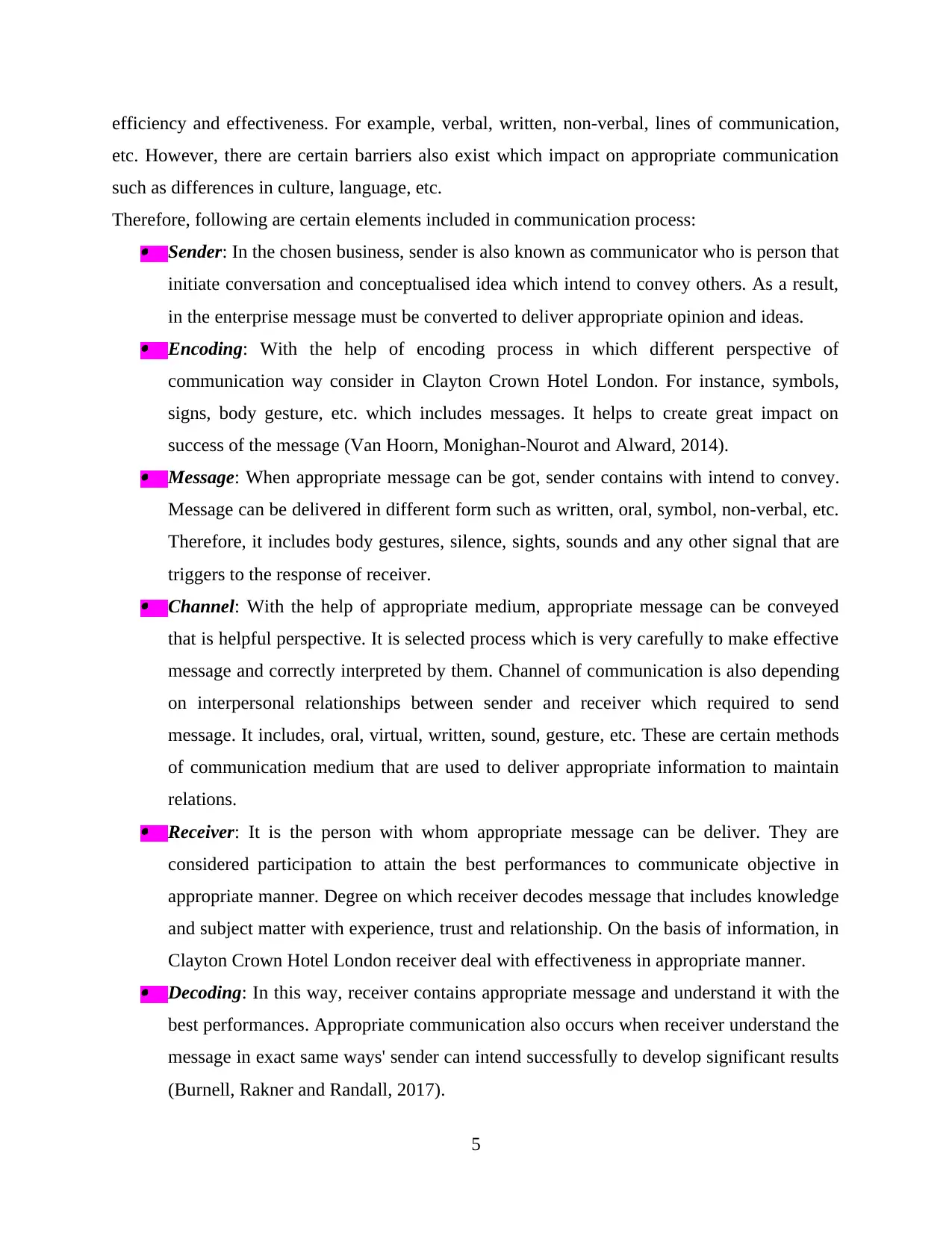
efficiency and effectiveness. For example, verbal, written, non-verbal, lines of communication,
etc. However, there are certain barriers also exist which impact on appropriate communication
such as differences in culture, language, etc.
Therefore, following are certain elements included in communication process: Sender: In the chosen business, sender is also known as communicator who is person that
initiate conversation and conceptualised idea which intend to convey others. As a result,
in the enterprise message must be converted to deliver appropriate opinion and ideas. Encoding: With the help of encoding process in which different perspective of
communication way consider in Clayton Crown Hotel London. For instance, symbols,
signs, body gesture, etc. which includes messages. It helps to create great impact on
success of the message (Van Hoorn, Monighan-Nourot and Alward, 2014). Message: When appropriate message can be got, sender contains with intend to convey.
Message can be delivered in different form such as written, oral, symbol, non-verbal, etc.
Therefore, it includes body gestures, silence, sights, sounds and any other signal that are
triggers to the response of receiver. Channel: With the help of appropriate medium, appropriate message can be conveyed
that is helpful perspective. It is selected process which is very carefully to make effective
message and correctly interpreted by them. Channel of communication is also depending
on interpersonal relationships between sender and receiver which required to send
message. It includes, oral, virtual, written, sound, gesture, etc. These are certain methods
of communication medium that are used to deliver appropriate information to maintain
relations. Receiver: It is the person with whom appropriate message can be deliver. They are
considered participation to attain the best performances to communicate objective in
appropriate manner. Degree on which receiver decodes message that includes knowledge
and subject matter with experience, trust and relationship. On the basis of information, in
Clayton Crown Hotel London receiver deal with effectiveness in appropriate manner. Decoding: In this way, receiver contains appropriate message and understand it with the
best performances. Appropriate communication also occurs when receiver understand the
message in exact same ways' sender can intend successfully to develop significant results
(Burnell, Rakner and Randall, 2017).
5
etc. However, there are certain barriers also exist which impact on appropriate communication
such as differences in culture, language, etc.
Therefore, following are certain elements included in communication process: Sender: In the chosen business, sender is also known as communicator who is person that
initiate conversation and conceptualised idea which intend to convey others. As a result,
in the enterprise message must be converted to deliver appropriate opinion and ideas. Encoding: With the help of encoding process in which different perspective of
communication way consider in Clayton Crown Hotel London. For instance, symbols,
signs, body gesture, etc. which includes messages. It helps to create great impact on
success of the message (Van Hoorn, Monighan-Nourot and Alward, 2014). Message: When appropriate message can be got, sender contains with intend to convey.
Message can be delivered in different form such as written, oral, symbol, non-verbal, etc.
Therefore, it includes body gestures, silence, sights, sounds and any other signal that are
triggers to the response of receiver. Channel: With the help of appropriate medium, appropriate message can be conveyed
that is helpful perspective. It is selected process which is very carefully to make effective
message and correctly interpreted by them. Channel of communication is also depending
on interpersonal relationships between sender and receiver which required to send
message. It includes, oral, virtual, written, sound, gesture, etc. These are certain methods
of communication medium that are used to deliver appropriate information to maintain
relations. Receiver: It is the person with whom appropriate message can be deliver. They are
considered participation to attain the best performances to communicate objective in
appropriate manner. Degree on which receiver decodes message that includes knowledge
and subject matter with experience, trust and relationship. On the basis of information, in
Clayton Crown Hotel London receiver deal with effectiveness in appropriate manner. Decoding: In this way, receiver contains appropriate message and understand it with the
best performances. Appropriate communication also occurs when receiver understand the
message in exact same ways' sender can intend successfully to develop significant results
(Burnell, Rakner and Randall, 2017).
5
Paraphrase This Document
Need a fresh take? Get an instant paraphrase of this document with our AI Paraphraser
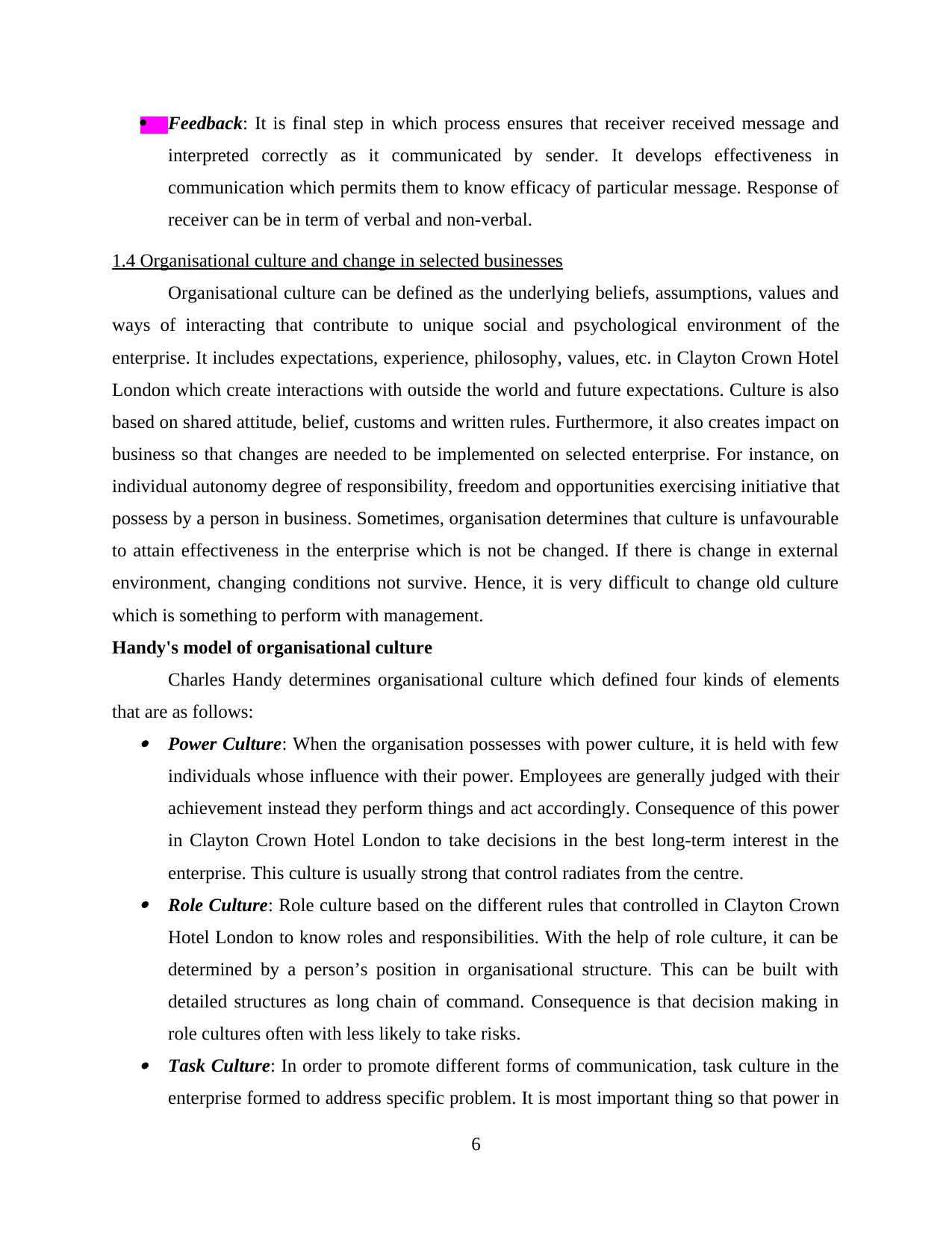
Feedback: It is final step in which process ensures that receiver received message and
interpreted correctly as it communicated by sender. It develops effectiveness in
communication which permits them to know efficacy of particular message. Response of
receiver can be in term of verbal and non-verbal.
1.4 Organisational culture and change in selected businesses
Organisational culture can be defined as the underlying beliefs, assumptions, values and
ways of interacting that contribute to unique social and psychological environment of the
enterprise. It includes expectations, experience, philosophy, values, etc. in Clayton Crown Hotel
London which create interactions with outside the world and future expectations. Culture is also
based on shared attitude, belief, customs and written rules. Furthermore, it also creates impact on
business so that changes are needed to be implemented on selected enterprise. For instance, on
individual autonomy degree of responsibility, freedom and opportunities exercising initiative that
possess by a person in business. Sometimes, organisation determines that culture is unfavourable
to attain effectiveness in the enterprise which is not be changed. If there is change in external
environment, changing conditions not survive. Hence, it is very difficult to change old culture
which is something to perform with management.
Handy's model of organisational culture
Charles Handy determines organisational culture which defined four kinds of elements
that are as follows: Power Culture: When the organisation possesses with power culture, it is held with few
individuals whose influence with their power. Employees are generally judged with their
achievement instead they perform things and act accordingly. Consequence of this power
in Clayton Crown Hotel London to take decisions in the best long-term interest in the
enterprise. This culture is usually strong that control radiates from the centre. Role Culture: Role culture based on the different rules that controlled in Clayton Crown
Hotel London to know roles and responsibilities. With the help of role culture, it can be
determined by a person’s position in organisational structure. This can be built with
detailed structures as long chain of command. Consequence is that decision making in
role cultures often with less likely to take risks. Task Culture: In order to promote different forms of communication, task culture in the
enterprise formed to address specific problem. It is most important thing so that power in
6
interpreted correctly as it communicated by sender. It develops effectiveness in
communication which permits them to know efficacy of particular message. Response of
receiver can be in term of verbal and non-verbal.
1.4 Organisational culture and change in selected businesses
Organisational culture can be defined as the underlying beliefs, assumptions, values and
ways of interacting that contribute to unique social and psychological environment of the
enterprise. It includes expectations, experience, philosophy, values, etc. in Clayton Crown Hotel
London which create interactions with outside the world and future expectations. Culture is also
based on shared attitude, belief, customs and written rules. Furthermore, it also creates impact on
business so that changes are needed to be implemented on selected enterprise. For instance, on
individual autonomy degree of responsibility, freedom and opportunities exercising initiative that
possess by a person in business. Sometimes, organisation determines that culture is unfavourable
to attain effectiveness in the enterprise which is not be changed. If there is change in external
environment, changing conditions not survive. Hence, it is very difficult to change old culture
which is something to perform with management.
Handy's model of organisational culture
Charles Handy determines organisational culture which defined four kinds of elements
that are as follows: Power Culture: When the organisation possesses with power culture, it is held with few
individuals whose influence with their power. Employees are generally judged with their
achievement instead they perform things and act accordingly. Consequence of this power
in Clayton Crown Hotel London to take decisions in the best long-term interest in the
enterprise. This culture is usually strong that control radiates from the centre. Role Culture: Role culture based on the different rules that controlled in Clayton Crown
Hotel London to know roles and responsibilities. With the help of role culture, it can be
determined by a person’s position in organisational structure. This can be built with
detailed structures as long chain of command. Consequence is that decision making in
role cultures often with less likely to take risks. Task Culture: In order to promote different forms of communication, task culture in the
enterprise formed to address specific problem. It is most important thing so that power in
6
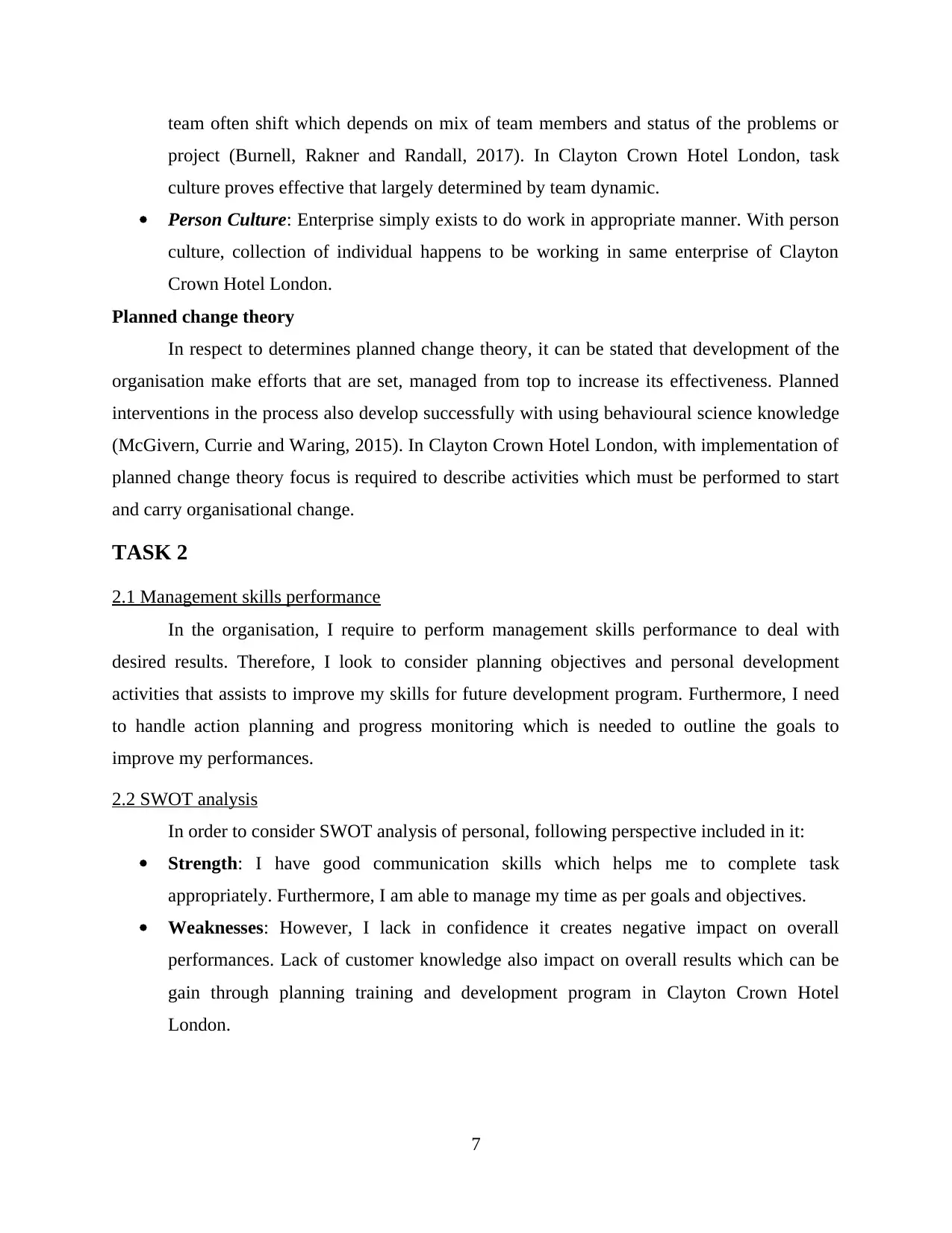
team often shift which depends on mix of team members and status of the problems or
project (Burnell, Rakner and Randall, 2017). In Clayton Crown Hotel London, task
culture proves effective that largely determined by team dynamic.
Person Culture: Enterprise simply exists to do work in appropriate manner. With person
culture, collection of individual happens to be working in same enterprise of Clayton
Crown Hotel London.
Planned change theory
In respect to determines planned change theory, it can be stated that development of the
organisation make efforts that are set, managed from top to increase its effectiveness. Planned
interventions in the process also develop successfully with using behavioural science knowledge
(McGivern, Currie and Waring, 2015). In Clayton Crown Hotel London, with implementation of
planned change theory focus is required to describe activities which must be performed to start
and carry organisational change.
TASK 2
2.1 Management skills performance
In the organisation, I require to perform management skills performance to deal with
desired results. Therefore, I look to consider planning objectives and personal development
activities that assists to improve my skills for future development program. Furthermore, I need
to handle action planning and progress monitoring which is needed to outline the goals to
improve my performances.
2.2 SWOT analysis
In order to consider SWOT analysis of personal, following perspective included in it:
Strength: I have good communication skills which helps me to complete task
appropriately. Furthermore, I am able to manage my time as per goals and objectives.
Weaknesses: However, I lack in confidence it creates negative impact on overall
performances. Lack of customer knowledge also impact on overall results which can be
gain through planning training and development program in Clayton Crown Hotel
London.
7
project (Burnell, Rakner and Randall, 2017). In Clayton Crown Hotel London, task
culture proves effective that largely determined by team dynamic.
Person Culture: Enterprise simply exists to do work in appropriate manner. With person
culture, collection of individual happens to be working in same enterprise of Clayton
Crown Hotel London.
Planned change theory
In respect to determines planned change theory, it can be stated that development of the
organisation make efforts that are set, managed from top to increase its effectiveness. Planned
interventions in the process also develop successfully with using behavioural science knowledge
(McGivern, Currie and Waring, 2015). In Clayton Crown Hotel London, with implementation of
planned change theory focus is required to describe activities which must be performed to start
and carry organisational change.
TASK 2
2.1 Management skills performance
In the organisation, I require to perform management skills performance to deal with
desired results. Therefore, I look to consider planning objectives and personal development
activities that assists to improve my skills for future development program. Furthermore, I need
to handle action planning and progress monitoring which is needed to outline the goals to
improve my performances.
2.2 SWOT analysis
In order to consider SWOT analysis of personal, following perspective included in it:
Strength: I have good communication skills which helps me to complete task
appropriately. Furthermore, I am able to manage my time as per goals and objectives.
Weaknesses: However, I lack in confidence it creates negative impact on overall
performances. Lack of customer knowledge also impact on overall results which can be
gain through planning training and development program in Clayton Crown Hotel
London.
7
⊘ This is a preview!⊘
Do you want full access?
Subscribe today to unlock all pages.

Trusted by 1+ million students worldwide
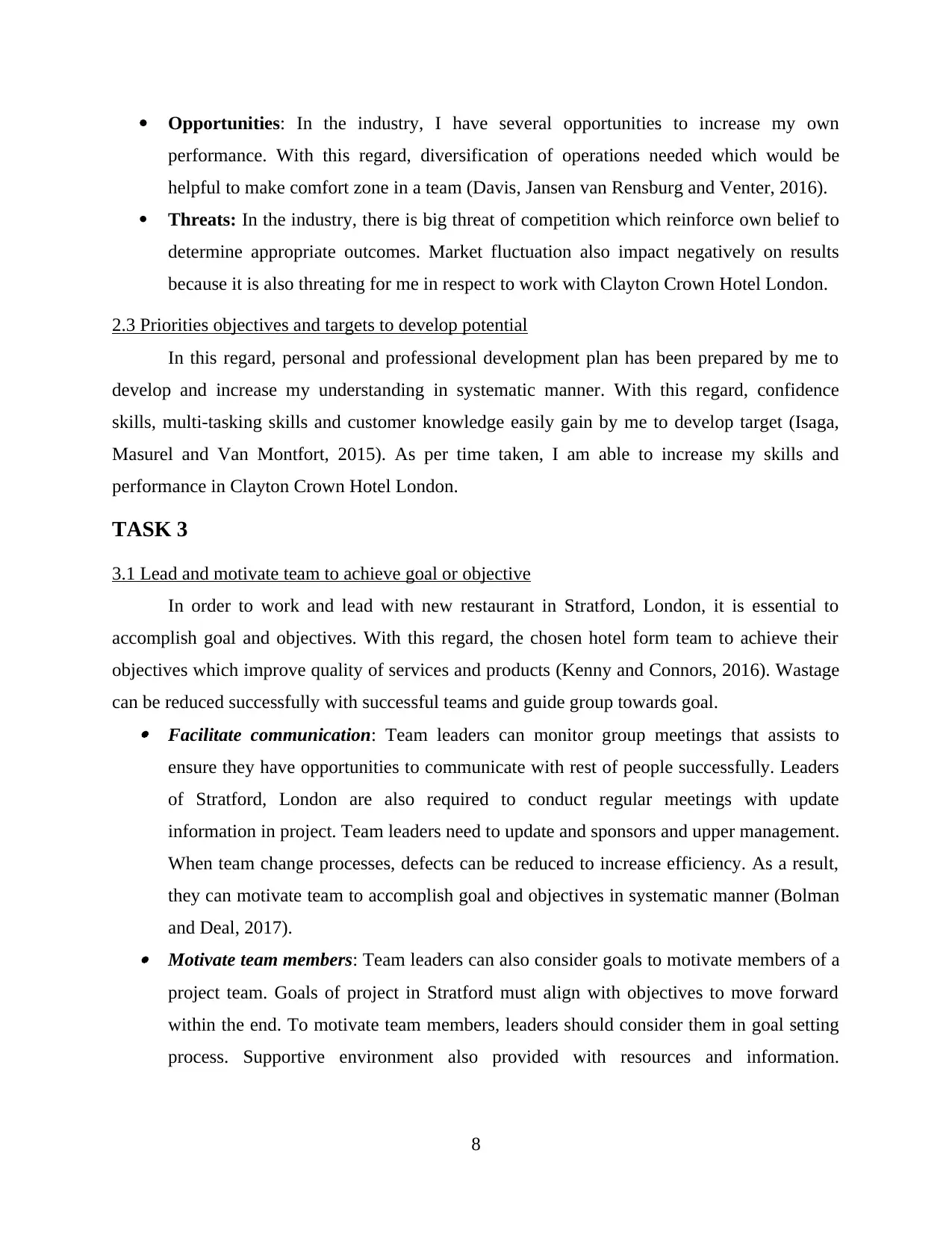
Opportunities: In the industry, I have several opportunities to increase my own
performance. With this regard, diversification of operations needed which would be
helpful to make comfort zone in a team (Davis, Jansen van Rensburg and Venter, 2016).
Threats: In the industry, there is big threat of competition which reinforce own belief to
determine appropriate outcomes. Market fluctuation also impact negatively on results
because it is also threating for me in respect to work with Clayton Crown Hotel London.
2.3 Priorities objectives and targets to develop potential
In this regard, personal and professional development plan has been prepared by me to
develop and increase my understanding in systematic manner. With this regard, confidence
skills, multi-tasking skills and customer knowledge easily gain by me to develop target (Isaga,
Masurel and Van Montfort, 2015). As per time taken, I am able to increase my skills and
performance in Clayton Crown Hotel London.
TASK 3
3.1 Lead and motivate team to achieve goal or objective
In order to work and lead with new restaurant in Stratford, London, it is essential to
accomplish goal and objectives. With this regard, the chosen hotel form team to achieve their
objectives which improve quality of services and products (Kenny and Connors, 2016). Wastage
can be reduced successfully with successful teams and guide group towards goal. Facilitate communication: Team leaders can monitor group meetings that assists to
ensure they have opportunities to communicate with rest of people successfully. Leaders
of Stratford, London are also required to conduct regular meetings with update
information in project. Team leaders need to update and sponsors and upper management.
When team change processes, defects can be reduced to increase efficiency. As a result,
they can motivate team to accomplish goal and objectives in systematic manner (Bolman
and Deal, 2017). Motivate team members: Team leaders can also consider goals to motivate members of a
project team. Goals of project in Stratford must align with objectives to move forward
within the end. To motivate team members, leaders should consider them in goal setting
process. Supportive environment also provided with resources and information.
8
performance. With this regard, diversification of operations needed which would be
helpful to make comfort zone in a team (Davis, Jansen van Rensburg and Venter, 2016).
Threats: In the industry, there is big threat of competition which reinforce own belief to
determine appropriate outcomes. Market fluctuation also impact negatively on results
because it is also threating for me in respect to work with Clayton Crown Hotel London.
2.3 Priorities objectives and targets to develop potential
In this regard, personal and professional development plan has been prepared by me to
develop and increase my understanding in systematic manner. With this regard, confidence
skills, multi-tasking skills and customer knowledge easily gain by me to develop target (Isaga,
Masurel and Van Montfort, 2015). As per time taken, I am able to increase my skills and
performance in Clayton Crown Hotel London.
TASK 3
3.1 Lead and motivate team to achieve goal or objective
In order to work and lead with new restaurant in Stratford, London, it is essential to
accomplish goal and objectives. With this regard, the chosen hotel form team to achieve their
objectives which improve quality of services and products (Kenny and Connors, 2016). Wastage
can be reduced successfully with successful teams and guide group towards goal. Facilitate communication: Team leaders can monitor group meetings that assists to
ensure they have opportunities to communicate with rest of people successfully. Leaders
of Stratford, London are also required to conduct regular meetings with update
information in project. Team leaders need to update and sponsors and upper management.
When team change processes, defects can be reduced to increase efficiency. As a result,
they can motivate team to accomplish goal and objectives in systematic manner (Bolman
and Deal, 2017). Motivate team members: Team leaders can also consider goals to motivate members of a
project team. Goals of project in Stratford must align with objectives to move forward
within the end. To motivate team members, leaders should consider them in goal setting
process. Supportive environment also provided with resources and information.
8
Paraphrase This Document
Need a fresh take? Get an instant paraphrase of this document with our AI Paraphraser
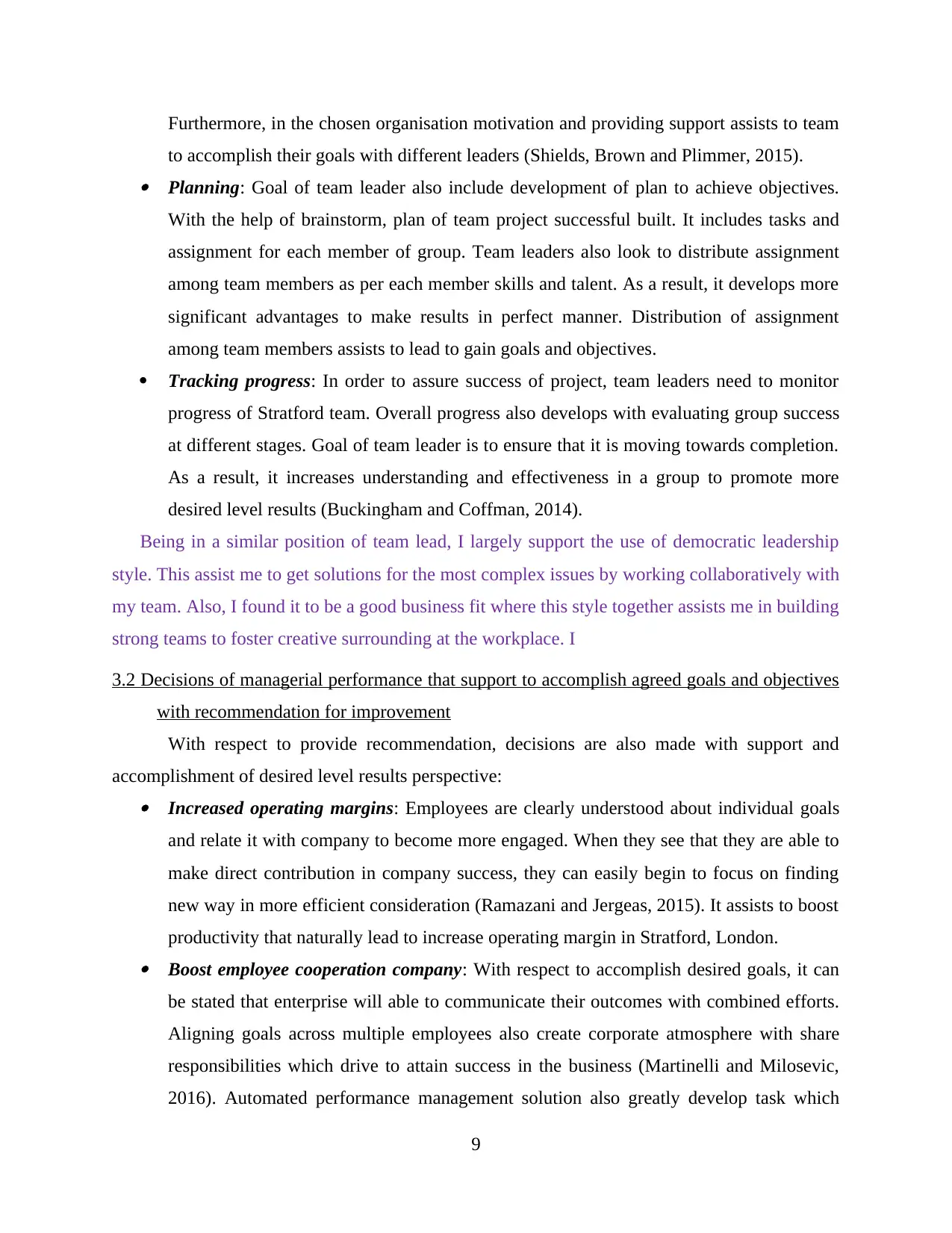
Furthermore, in the chosen organisation motivation and providing support assists to team
to accomplish their goals with different leaders (Shields, Brown and Plimmer, 2015). Planning: Goal of team leader also include development of plan to achieve objectives.
With the help of brainstorm, plan of team project successful built. It includes tasks and
assignment for each member of group. Team leaders also look to distribute assignment
among team members as per each member skills and talent. As a result, it develops more
significant advantages to make results in perfect manner. Distribution of assignment
among team members assists to lead to gain goals and objectives.
Tracking progress: In order to assure success of project, team leaders need to monitor
progress of Stratford team. Overall progress also develops with evaluating group success
at different stages. Goal of team leader is to ensure that it is moving towards completion.
As a result, it increases understanding and effectiveness in a group to promote more
desired level results (Buckingham and Coffman, 2014).
Being in a similar position of team lead, I largely support the use of democratic leadership
style. This assist me to get solutions for the most complex issues by working collaboratively with
my team. Also, I found it to be a good business fit where this style together assists me in building
strong teams to foster creative surrounding at the workplace. I
3.2 Decisions of managerial performance that support to accomplish agreed goals and objectives
with recommendation for improvement
With respect to provide recommendation, decisions are also made with support and
accomplishment of desired level results perspective: Increased operating margins: Employees are clearly understood about individual goals
and relate it with company to become more engaged. When they see that they are able to
make direct contribution in company success, they can easily begin to focus on finding
new way in more efficient consideration (Ramazani and Jergeas, 2015). It assists to boost
productivity that naturally lead to increase operating margin in Stratford, London. Boost employee cooperation company: With respect to accomplish desired goals, it can
be stated that enterprise will able to communicate their outcomes with combined efforts.
Aligning goals across multiple employees also create corporate atmosphere with share
responsibilities which drive to attain success in the business (Martinelli and Milosevic,
2016). Automated performance management solution also greatly develop task which
9
to accomplish their goals with different leaders (Shields, Brown and Plimmer, 2015). Planning: Goal of team leader also include development of plan to achieve objectives.
With the help of brainstorm, plan of team project successful built. It includes tasks and
assignment for each member of group. Team leaders also look to distribute assignment
among team members as per each member skills and talent. As a result, it develops more
significant advantages to make results in perfect manner. Distribution of assignment
among team members assists to lead to gain goals and objectives.
Tracking progress: In order to assure success of project, team leaders need to monitor
progress of Stratford team. Overall progress also develops with evaluating group success
at different stages. Goal of team leader is to ensure that it is moving towards completion.
As a result, it increases understanding and effectiveness in a group to promote more
desired level results (Buckingham and Coffman, 2014).
Being in a similar position of team lead, I largely support the use of democratic leadership
style. This assist me to get solutions for the most complex issues by working collaboratively with
my team. Also, I found it to be a good business fit where this style together assists me in building
strong teams to foster creative surrounding at the workplace. I
3.2 Decisions of managerial performance that support to accomplish agreed goals and objectives
with recommendation for improvement
With respect to provide recommendation, decisions are also made with support and
accomplishment of desired level results perspective: Increased operating margins: Employees are clearly understood about individual goals
and relate it with company to become more engaged. When they see that they are able to
make direct contribution in company success, they can easily begin to focus on finding
new way in more efficient consideration (Ramazani and Jergeas, 2015). It assists to boost
productivity that naturally lead to increase operating margin in Stratford, London. Boost employee cooperation company: With respect to accomplish desired goals, it can
be stated that enterprise will able to communicate their outcomes with combined efforts.
Aligning goals across multiple employees also create corporate atmosphere with share
responsibilities which drive to attain success in the business (Martinelli and Milosevic,
2016). Automated performance management solution also greatly develop task which
9
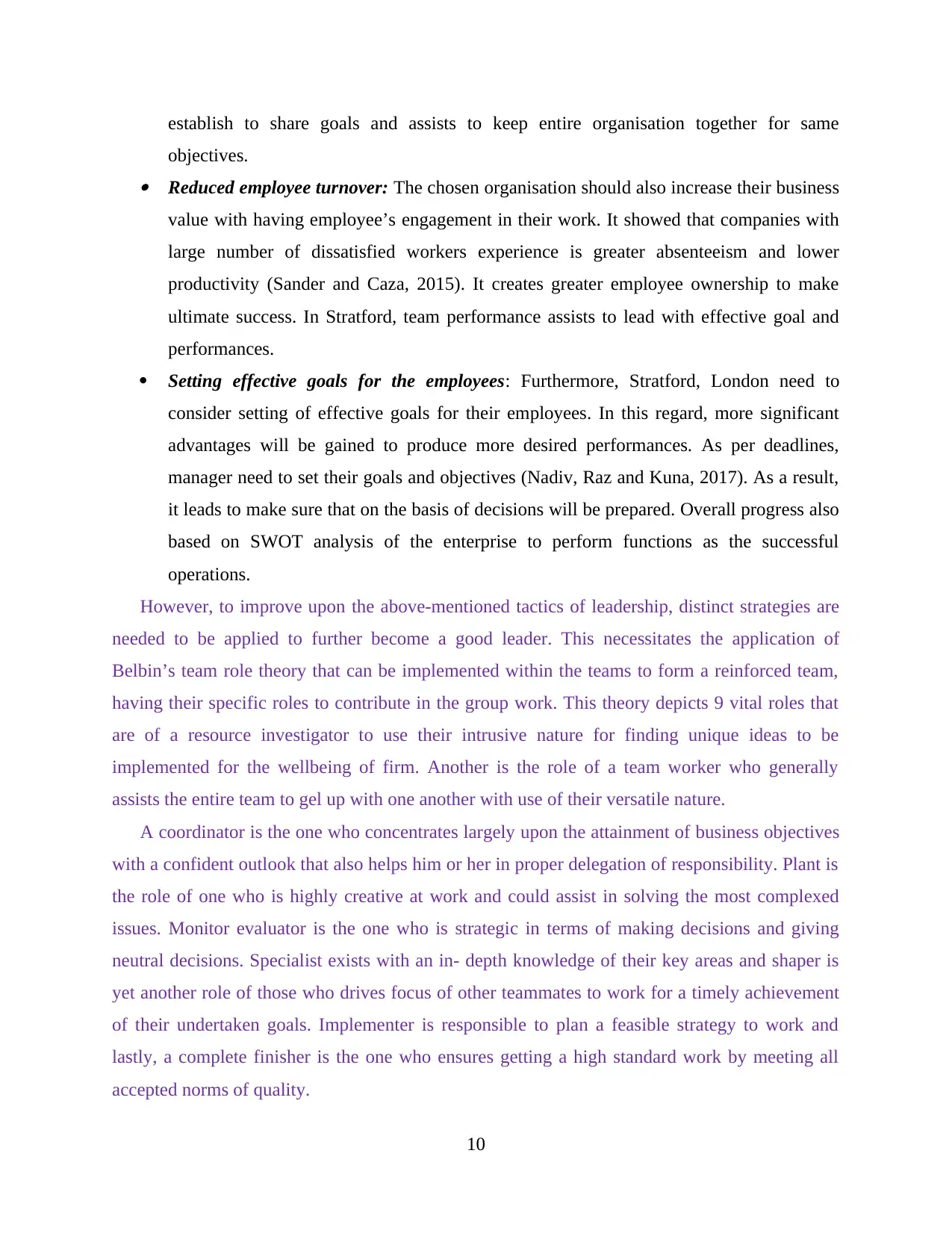
establish to share goals and assists to keep entire organisation together for same
objectives. Reduced employee turnover: The chosen organisation should also increase their business
value with having employee’s engagement in their work. It showed that companies with
large number of dissatisfied workers experience is greater absenteeism and lower
productivity (Sander and Caza, 2015). It creates greater employee ownership to make
ultimate success. In Stratford, team performance assists to lead with effective goal and
performances.
Setting effective goals for the employees: Furthermore, Stratford, London need to
consider setting of effective goals for their employees. In this regard, more significant
advantages will be gained to produce more desired performances. As per deadlines,
manager need to set their goals and objectives (Nadiv, Raz and Kuna, 2017). As a result,
it leads to make sure that on the basis of decisions will be prepared. Overall progress also
based on SWOT analysis of the enterprise to perform functions as the successful
operations.
However, to improve upon the above-mentioned tactics of leadership, distinct strategies are
needed to be applied to further become a good leader. This necessitates the application of
Belbin’s team role theory that can be implemented within the teams to form a reinforced team,
having their specific roles to contribute in the group work. This theory depicts 9 vital roles that
are of a resource investigator to use their intrusive nature for finding unique ideas to be
implemented for the wellbeing of firm. Another is the role of a team worker who generally
assists the entire team to gel up with one another with use of their versatile nature.
A coordinator is the one who concentrates largely upon the attainment of business objectives
with a confident outlook that also helps him or her in proper delegation of responsibility. Plant is
the role of one who is highly creative at work and could assist in solving the most complexed
issues. Monitor evaluator is the one who is strategic in terms of making decisions and giving
neutral decisions. Specialist exists with an in- depth knowledge of their key areas and shaper is
yet another role of those who drives focus of other teammates to work for a timely achievement
of their undertaken goals. Implementer is responsible to plan a feasible strategy to work and
lastly, a complete finisher is the one who ensures getting a high standard work by meeting all
accepted norms of quality.
10
objectives. Reduced employee turnover: The chosen organisation should also increase their business
value with having employee’s engagement in their work. It showed that companies with
large number of dissatisfied workers experience is greater absenteeism and lower
productivity (Sander and Caza, 2015). It creates greater employee ownership to make
ultimate success. In Stratford, team performance assists to lead with effective goal and
performances.
Setting effective goals for the employees: Furthermore, Stratford, London need to
consider setting of effective goals for their employees. In this regard, more significant
advantages will be gained to produce more desired performances. As per deadlines,
manager need to set their goals and objectives (Nadiv, Raz and Kuna, 2017). As a result,
it leads to make sure that on the basis of decisions will be prepared. Overall progress also
based on SWOT analysis of the enterprise to perform functions as the successful
operations.
However, to improve upon the above-mentioned tactics of leadership, distinct strategies are
needed to be applied to further become a good leader. This necessitates the application of
Belbin’s team role theory that can be implemented within the teams to form a reinforced team,
having their specific roles to contribute in the group work. This theory depicts 9 vital roles that
are of a resource investigator to use their intrusive nature for finding unique ideas to be
implemented for the wellbeing of firm. Another is the role of a team worker who generally
assists the entire team to gel up with one another with use of their versatile nature.
A coordinator is the one who concentrates largely upon the attainment of business objectives
with a confident outlook that also helps him or her in proper delegation of responsibility. Plant is
the role of one who is highly creative at work and could assist in solving the most complexed
issues. Monitor evaluator is the one who is strategic in terms of making decisions and giving
neutral decisions. Specialist exists with an in- depth knowledge of their key areas and shaper is
yet another role of those who drives focus of other teammates to work for a timely achievement
of their undertaken goals. Implementer is responsible to plan a feasible strategy to work and
lastly, a complete finisher is the one who ensures getting a high standard work by meeting all
accepted norms of quality.
10
⊘ This is a preview!⊘
Do you want full access?
Subscribe today to unlock all pages.

Trusted by 1+ million students worldwide
1 out of 22
Related Documents
Your All-in-One AI-Powered Toolkit for Academic Success.
+13062052269
info@desklib.com
Available 24*7 on WhatsApp / Email
![[object Object]](/_next/static/media/star-bottom.7253800d.svg)
Unlock your academic potential
Copyright © 2020–2025 A2Z Services. All Rights Reserved. Developed and managed by ZUCOL.




